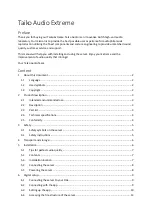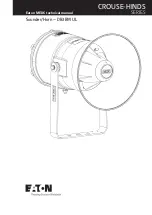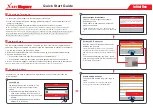
Ventilator Alarms
6-4
Operator's Manual
6.3.1
Low Pressure Alarm
The Low Pressure alarm determines the minimum pressure that must be attained in the breathing
circuit during mandatory breaths. It should be set as close to the patient’s normal peak pressure
as possible.
The Low Pressure alarm limit does not apply to any breaths in the SPONT mode or to spontaneous
breaths in SIMV mode.
Note:
The Low Pressure alarm and PEEP/CPAP settings are linked; the Low Pressure alarm limit must be greater
than the PEEP/CPAP setting. When NIV is on, increasing the PEEP/CPAP setting will automatically increase
the Low Pressure alarm setting to maintain a minimum interval of 1 cmH
2
O greater than the PEEP/CPAP
setting. When NIV is off, increasing the PEEP/CPAP setting will automatically increase the Low Pressure
alarm setting to maintain a minimum interval of 3 cmH
2
O greater than the PEEP/CPAP setting.
6.3.2
High Pressure Alarm
The High Pressure alarm setting determines the maximum pressure allowed in the breathing cir-
cuit. In general, it should be set 10–15 cmH
2
O above the patient’s normal peak pressure, but
always at or below a safe ventilating pressure.
6.3.3
Low Inspiratory Minute Volume Alarm
The Low Inspiratory Minute Volume alarm alerts the caregiver when delivered minute volume
decreases to the set alarm level. Delivered minute volume may decrease due to slowed or absent
patient breathing effort in any mode/breath type. It may also decrease due to worsening lung
conditions or secretion buildup in Pressure Control or Pressure Support.
This alarm may be linked with Backup Ventilation.
When the NIV feature is turned on, the Low Inspiratory Minute Volume alarm can be set to off.
6.3.4
Low Expiratory Minute Volume Alarm
The on-airway flow sensor must be in use for the Low Expiratory Minute Volume alarm.
The Low Expiratory Minute Volume alarm alerts the caregiver when exhaled minute volume
decreases to the set alarm level. Exhaled minute volume may decrease due to slowed or absent
patient breathing effort in any mode/breath type. It may also decrease due to worsening lung
conditions or secretion buildup in Pressure Control or Pressure Support. It may also decrease due
to leaks at the airway (such as deflated cuff) or in the breathing circuit.
This alarm is not compatible with use of a speaking valve. The speaking valve diverts the patient’s
exhaled gas around the trach tube so that it can pass through the vocal cords, and therefore the
gas does not exit the patient through the flow sensor. When using a speaking valve, turn NIV on
Summary of Contents for Newport HT70
Page 1: ...Operator s Manual Newport HT70 Ventilator with Accessories Plus Model TM...
Page 8: ...Page Left Intentionally Blank viii Operator s Manual...
Page 12: ...Page Left Intentionally Blank xii Operator s Manual...
Page 24: ...Introduction Page Left Intentionally Blank 1 12 Operator s Manual...
Page 72: ...Navigating the Screens Page Left Intentionally Blank 4 24 Operator s Manual...
Page 88: ...Operating the Ventilator Page Left Intentionally Blank 5 16 Operator s Manual...
Page 100: ...Ventilator Alarms Page Left Intentionally Blank 6 12 Operator s Manual...
Page 108: ...Battery Operation Page Left Intentionally Blank 7 8 Operator s Manual...
Page 138: ...Explanation of Modes and Controls Page Left Intentionally Blank 10 6 Operator s Manual...
Page 140: ...Quick Check Procedure Check Off Page Left Intentionally Blank A 2 Operator s Manual...
Page 142: ...Foldout Drawings B 2 Page left intentionally blank...
Page 144: ...Foldout Drawings B 4 Page left intentionally blank...
Page 146: ...Foldout Drawings B 6 Page left intentionally blank...
Page 147: ......
















































